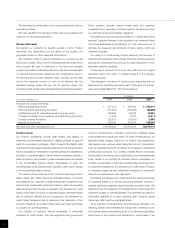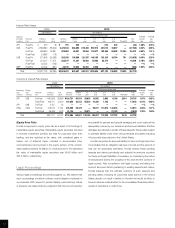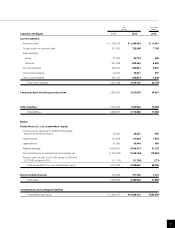Honda 2010 Annual Report Download - page 51
Download and view the complete annual report
Please find page 51 of the 2010 Honda annual report below. You can navigate through the pages in the report by either clicking on the pages listed below, or by using the keyword search tool below to find specific information within the annual report.
(Pension and Other Postretirement Benefits)
We have various pension plans covering substantially all of our
employees in Japan and certain employees in foreign countries.
Benefit obligations and pension costs are based on assumptions of
many factors, including the discount rate, the rate of salary increase
and the expected long-term rate of return on plan assets. The
discount rate is determined mainly based on the rates of high-quality
corporate bonds currently available and expected to be available
during the period to maturity of the defined benefit pension plans.
The salary increase assumptions reflect our actual experience as well
as near-term outlook. Honda determines the expected long-term
rate of return based on the investment policies. Honda considers the
eligible investment assets under investment policies, historical
experience, expected long-term rate of return under the investing
environment, and the long-term target allocations of the various asset
categories. Our assumed discount rate and rate of salary increase as
of March 31, 2010 were 2.0% and 2.3%, respectively, and our
assumed expected long-term rate of return for the year ended March
31, 2010 was 3.0% for Japanese plans. Our assumed discount rate
and rate of salary increase as of March 31, 2010 were 5.6-6.5% and
1.5-5.3%, respectively, and our assumed expected long-term rate of
return for fiscal 2010 was 6.5-8.0% for foreign plans.
We believe that the accounting estimates related to our pension
plans is “critical accounting estimate” because changes in these
estimates can materially affect our financial condition and results of
operations.
Actual results may differ from our assumptions, and the difference
is accumulated and amortized over future periods. Therefore, the
difference generally will be reflected as our recognized expenses in
future periods. We believe that the assumptions currently used are
appropriate, however, differences in actual expenses or changes in
assumptions could affect our pension costs and obligations,
including our cash requirements to fund such obligations.
The following table shows the effect of a 0.5% change in the
assumed discount rate and the expected long-term rate of return on
our funded status, equity, and pension expense.
We believe that our estimates and assumptions of unrecognized
tax benefits are reasonable, however, if our estimates of unrecognized
tax benefits and potential tax benefits are not representative of actual
outcomes, our consolidated financial statements could be materially
affected in the period of settlement or when the statutes of limitations
expire, as we treat these events as discrete items in the period of
resolution.
New Accounting Pronouncements
In October 2009, the Financial Accounting Standards Board (FASB)
issued Accounting Standards Update (ASU) 2009-13 “Multiple—
Deliverable Revenue Arrangements—a consensus of the FASB
Emerging Issues Task Force”, which will amend the FASB Accounting
Standards Codification (ASC) 605 “Revenue Recognition” for
arrangements with multiple deliverables to allow vendors to account
for products and services separately rather than as a combined unit.
This standard requires allocation of the overall consideration to each
deliverable in an arrangement with multiple deliverables using the
(Income Taxes)
Honda adopted the provision of Financial Accounting Standards
Board (FASB) Interpretation (FIN) No. 48, “Accounting for Uncertainty
in Income Taxes” which is now codified in the FASB Accounting
Standards Codification (ASC) 740 “Income Taxes” on April 1, 2007.
Honda is subject to income tax examinations in many tax jurisdictions
because Honda conducts its operations in various regions of the
world. We recognize the tax benefit from an uncertain tax position
based on the technical merits of the position when the position is
more likely than not to be sustained upon examination. Benefits from
tax positions that meet the more likely than not recognition threshold
are measured at the largest amount of benefit that is greater than
50% likelihood of being realized upon ultimate resolution. We
performed a comprehensive review of any uncertain tax positions in
accordance with this statement.
We believe our accounting for tax uncertainties is a “critical
accounting estimate” because it requires us to evaluate and assess
the probability of the outcome that could be realized upon ultimate
resolution. Our estimates may change in the future due to new
developments.
Japanese Plans Yen (billions)
Assumptions Percentage point change (%) Funded status Equity Pension expense
Discount rate +0.5/–0.5 –84.9/+95.7 +36.9/–47.7 –4.0/+4.2
Expected long-term rate of return +0.5/–0.5 — — –3.7/+3.7
Foreign Plans Yen (billions)
Assumptions Percentage point change (%) Funded status Equity Pension expense
Discount rate +0.5/–0.5 –31.0/+34.2 +18.5/–20.2 –3.0/+3.3
Expected long-term rate of return +0.5/–0.5 — — –1.8/+1.8
*1 Note that this sensitivity analysis may be asymmetric, and are specific to the base conditions at March 31, 2010.
*2 Funded status for fiscal 2010 is affected by March 31, 2010 assumptions.
Pension expense for fiscal 2010 is affected by March 31, 2009 assumptions.
49
























